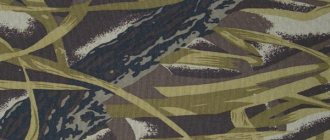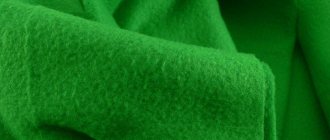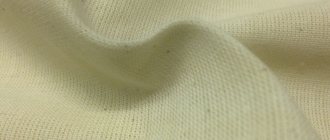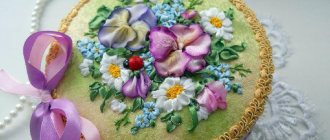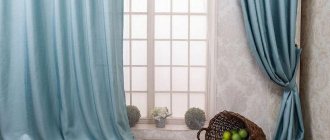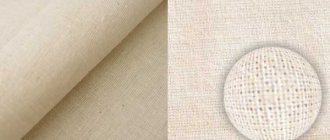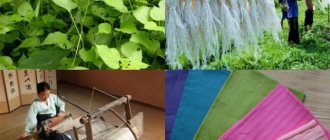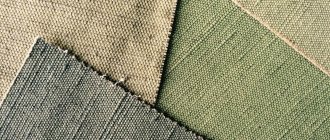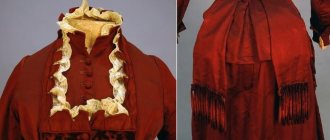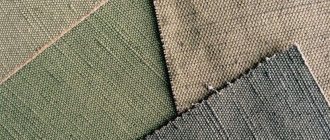What type of fabric is this?
In its pure form, denim is tough and dense. Now it is produced almost all over the world. The standard weave is twill with a slant from right to left.
Jeans colors
On the front side the fibers are painted. It is the main side of the canvas. The reverse side is represented by unpainted ducks. Coloring can be done either with natural dyes (indigo) using the boiling method, or with the use of artificial additives.
Advantages and disadvantages of denim
Jeans and other denim clothing attract buyers all over the world due to their high quality. What other benefits does jeans have:
- high strength;
- hygroscopicity;
- wear resistance;
- ease of care;
- convenience;
- beautiful appearance;
- variety of color and texture options;
- low creasing.
Jeans is a natural material, it does not electrify and does not attract particles of small lint. High-quality denim clothing can be worn for up to ten years without its appearance deteriorating. Even if the color of the fabric has changed, it will look no less noble.
Working with denim is extremely convenient. This fabric is dense and durable, does not crumble during cutting, does not stretch or lose shape.
What are the disadvantages of jeans? This dense and rough fabric takes quite a long time to dry and shrinks when washed. But with subsequent wear, clothing made from this material again takes on the desired shape. The paint rubs off faster in the area of the seams than on the surface of the fabric.
Origin story
Denim first appeared in the Middle Ages in Europe, in France. Weavers created durable cotton material from which they made ship sails.
In the mid-19th century, entrepreneur Levi Strauss decided to make pants with pockets for various accessories from it. These trousers have become very popular among miners due to their durability and comfort. After this, jeans began to gain more and more popularity.
However, in everyday life, this fabric deserved attention a little later, when films about cowboys appeared. The main characters were dressed in denim trousers and vests. To this day, jeans remain relevant.
Who invented jeans?
The development of denim began, in fact, with the manufacture of jeans. In 1853, American entrepreneur Levi Strauss came up with the idea of using durable hemp canvas pants as farm work clothes. This material was very durable and cheap because the sailing fleet was in decline.
It so happened that all of Strauss's goods were sold out, and he only had canvas left. It was decided to make durable pants from it - they sold out instantly. For the next batch we used French denim fabric.
This is how the world's first classic jeans were created. Denim was a practical, very dense material, tough and rough. The fabric was difficult to tear and provided excellent protection for the wearer while working.
The studded pants sold out quickly
The invention was patented. Levi Strauss & Co sold 21,000 copper-studded pants and jackets in its first year. The company also produced work overalls with many convenient pockets.
The heyday of jeans came during the gold rush. Searchers appreciated durable, durable items that were affordable and washable, unlike leather clothing.
Less than a hundred years later, cotton almost completely replaced hemp fabric. In the 1960s, the “denim revolution” occurred - new types and colors of fabric appeared, and the range of clothing expanded.
Fabric composition and its properties
Jeans are made from cotton. It may also contain synthetic threads. Often these are elastane and viscose. Such inclusions help make the fabric less rough and more elastic, which makes it comfortable to wear. Synthetic threads allow things to fit beautifully.
Cotton
What are the properties of cotton or cotton fabric? What are its areas of application?
more details
A characteristic feature of the fabric is a relief in the form of an oblique hem. The ratio of cotton and synthetic fibers, as well as the density of the weaving of the threads, determines how strongly the texture will be expressed.
Types of fabric
Types of material:
Stretch (may be called denim jersey)
The fabric density is average, but at the same time it has increased elasticity. It stretches well and fits the figure beautifully. Mainly used for sewing tight pants. Elasticity is provided by lycra in the fabric composition. Instead of lycra, Chinese nettle, called ramie, can be used.
Chambray
Thin, soft and lightweight cotton material. But outwardly it looks like jeans. Chambray is used for sewing skirts, summer dresses, and shirts.
Ecru
It has a low density, about the same as chambray. It is made from undyed cotton, so it has a white color with a yellowish or dirty tint. Used for eco-style clothing models.
Denim
One of the popular and expensive types of jeans. It is durable with low elasticity and has a characteristic relief in the form of an oblique strip.
Broken twill
In this case, the weaving looks like a herringbone. Used for sewing jackets and trousers.
Gin
A cheaper option, has a diagonal weave. It is used for sewing inexpensive clothes.
Jeans-silk
Thin fabric with a smooth texture and shiny surface.
Cotton-denim
A thin material made from natural cotton is used in the production of shirts and summer clothing. Its texture is similar to cotton.
Jeans bengaleen
Durable, stretchy and soft fabric.
Hemp jeans
Produced on the basis of hemp fibers. This is a strong, rough material of high strength. Shoes, bags, and outerwear are made from it.
Furniture type
It contains a lot of lycra and elastane, so the fabric is very elastic and soft. Furniture is upholstered with it.
The history of jeans
The history of the creation of jeans is interesting; according to one version, they originated in Italy, namely in Genoa, as well as in France, in Nimes. Let us turn to the etymology of the word jeans. The term "genes" is identical and has similarities with the word "jeans".
So, in the city of Nîmes, for a long time they tried to develop denim, this fabric was called denim, which translates as “from Nîmes”. In Genoa, jeans were made from cotton fabric and were used as work clothes. Denim was of high quality - it was a wear-resistant material for workwear. The first models were painted with paint that was imported from India, and later jeans began to be painted with paint that was developed using a special technology in Germany.
Around the 17th century, jeans became more affordable and were considered one of the best options for workwear. They began to be exported from France and Italy to Europe and other countries of the world.
It is curious that jeans gained popularity in the United States only in 1873, it was at that time that entrepreneur Levi Strauss introduced to the public a jumpsuit he made from denim. The famous tailor Jacob Davis proposed to patent jeans and introduced something new, so rivets and fasteners appeared on the pockets of these clothes, thereby increasing the strength and extending the service life of these products. A little later, Strauss patented a denim overalls; the best option for sewing such clothes was denim fabric, this material was produced in America. At that time, jeans were still widespread mainly as work and workwear. Surprisingly, this fabric was used by Italian sailors when transporting goods; the fabric got wet for a long time and perfectly protected from the wind.
Over time, jeans spread widely throughout the world; in Russia, jeans appeared in 1957, it was then that many foreigners from several countries of the world arrived during the youth festival. Students from Russia really liked the jeans, and a little later, 7 years later, the first jeans went on sale in Russia. They were very popular and quickly came into use. After a while, almost every student had jeans in their wardrobe. Many famous actresses, actors, as well as singers and musicians who appeared on stage in these clothes played a major role in the spread of jeans. Thus, this contributed to the even greater distribution of these products.
Today, jeans are an indispensable item both for going to work and for a party or business dinner. This is a universal item that is used by many famous and famous designers and fashion designers. They go perfectly with almost all popular styles. High quality, increased wear resistance, as well as simple and easy maintenance guarantee great demand and a long service life.
Pros and cons of fabric
The main advantages of denim material:
- High wear resistance. It is very difficult to tear due to the weaving of the threads too often. The highest quality products can last more than 10 years.
- Thermal protection.
- Hygroscopicity.
- It is not electrified, so the material does not attract dust.
- Good breathability.
- Almost does not wrinkle.
- Large selection in price and model segments.
The disadvantages include the following:
- Gives strong shrinkage, especially after the first wash. Things that have added elastane shrink the most.
- It is better to wash denim clothes separately, as they may stain.
- If not properly cared for, things become dull, stretch, that is, they lose their quality.
Features of denim
There are many varieties of denim. But they are all made from natural fibers - cotton. It is customary to distinguish the following types:
- Mexican (the fibers are long enough to ensure smoothness and absence of scars);
- Indian or Asian (the most popular and characterized by low cost);
- Barbadian or Zimbabwean (rare and expensive, gives softness and shine).
In stores you can also find fabric sheets made from Tencel (cellulose material). Things made from them are soft, light and velvety. Some believe that such material could well replace classic cotton.
As a rule, threads for fabric fabric are made using special ring spinning machines. Such equipment carefully twists the fibers, making the fabric quite strong.
There is also a method for producing threads that uses rotary pneumomechanical devices. They “tangle” the fibers rather than twisting them. By the way, such machines work many times faster than ring-spinning machines, making the resulting material cheaper. Some manufacturers like to mix threads obtained from different methods.
The strongest denim fabric is made using twill weave. Its distinctive feature is a pronounced relief - a diagonal hem. This material does not require complete painting. It is enough to color only the longitudinal threads. Cross threads or wefts are not processed.
Traditionally, indigo dye is used to dye denim fabric. The shade is played with using sulfur dyes, which make it possible to obtain black, gray, white, red, pink and other jeans.
What standards are used in production? What do they take into account?
GOST 21790-2005 “Cotton and mixed clothing fabrics” states that after washing, denim material can shrink by no more than 5%. It is also stated that its surfaces can withstand at least 2000 abrasion cycles.
Physical and hygienic indicators in the Russian Federation are regulated by SanPiN 2.4.7/1.1.1286-03 “Hygienic requirements for clothing for children, adolescents, and adults.” It states that air permeability should be at least 0.1 liters per 1 square meter. m. of canvas.
